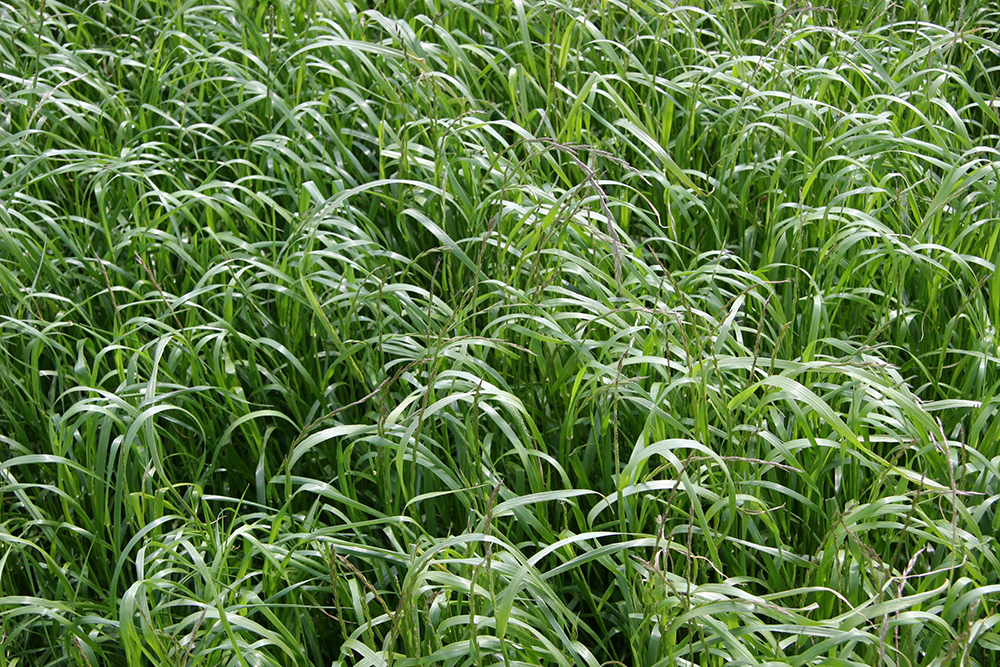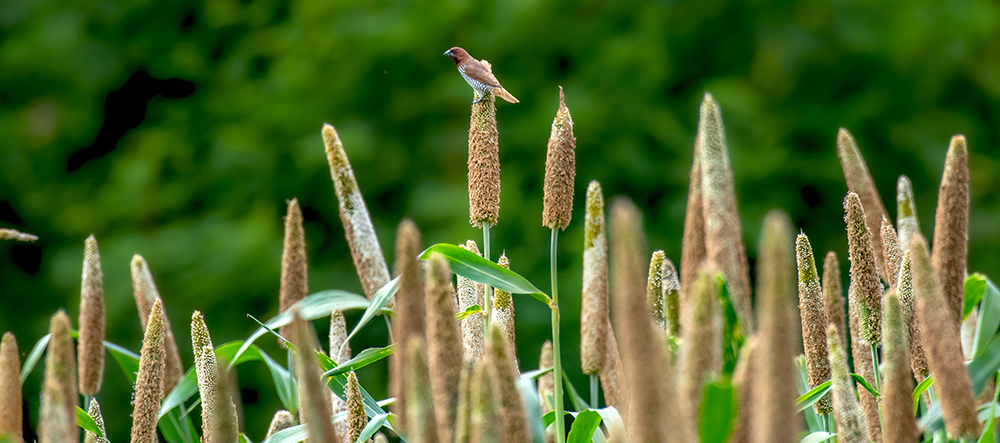Cover Crops
Cover Crops thompsbbCover crops help hold the soil in place and reduce erosion. They are recommended on slopes 3:1 (meaning a 3-foot horizontal run for every 1 foot of vertical rise) or steeper. Some roadside managers will only use cover crops on slopes they consider to be steep. However, they can also be used on more level ground to reduce the amount of weeds. Cover crops can outcompete weeds by taking up nitrogen and phosphorus from the soil, reducing the amounts that could otherwise fuel weed growth. Since cover crops are annual plants, they will be gone by the time native plants start to take off during the second growing season after initial planting.
There are two kinds of cover crops. Cover crops planted with the permanent native seed mix are called “nurse crops” or “companion crops.” Those planted by themselves outside of the optimal native seed planting season are called “temporary seedings” or “stabilizer crops.”
Oats (Avena sativa), annual ryegrass (Lolium multiflorum), and winter wheat (Triticum aestivum) are excellent cover crops because they are inexpensive, easy to establish, and not overly competitive.
Clarifying the Ryes

Many kinds of ryegrass are used as cover crops, including annual ryegrass, perennial ryegrass (Lolium perenne), and winter/cereal/grain ryegrass (all names for the same plant, Secale cereale). Perennial ryegrass is less aggressive than Secale cereale. Some roadside managers may include low rates of perennial ryegrass as a cover crop but use a shorter turf variety rather than a robust forage variety.
For native plantings, winter wheat is preferred over Secale cereale for cover crop purposes. Secale cereale is taller, more persistent, and can produce allelopathic compounds, meaning it could release biochemicals that inhibit the growth of wildflowers. Planting minimal amounts of ryegrass (5–10 lbs./acre) will reduce competition with natives. Annual ryegrass may germinate better with dormant or frost seeding.
Recommended Nurse/Companion Crops (Planted With the Native Seed)—per Acre
Spring
- 1.5 bushels of oats
- 1 bushel of oats and 5 lbs. of annual ryegrass
Summer
- 2 bushels of oats
- 1 bushel of oats and 10 lbs. of annual ryegrass
Fall
- 30 lbs. of winter wheat

Recommended Temporary Seedings/Stabilizer Crops (Native Seed to Follow in the Spring or Fall)—per Acre
Summer
- 1 bushel of oats plus 3–5 lbs. of annual rye and one of the following warm-season species:
- 5 lbs. of piper sudangrass
- 10 lbs. of pearl millet (reduce the amount if planting in rich black soil)
- 30 lbs. of grain for forage sorghum
Use moderate rates when seeding piper sudangrass, pearl millet, or sorghum. One good rainfall can cause mass germination. Piper sudangrass may cause concern among landowners because it is sometimes confused with the weed shattercane.
Fall
- 3–5 lbs. of annual ryegrass
- 45 lbs. of winter ryegrass
- 60 lbs. of winter wheat
| Species | Pounds in a bushel | Seeds in an ounce | Seeding at 1 bushel/acre results in |
|---|---|---|---|
| Oats | 32 | 910 | 10 seeds per square foot |
| Winter wheat | 60 | 937 | 20 seeds per square foot |
| Annual rye | - | 12,710 | Seeding at 10 pounds per acre results in 46 seeds per square foot |
Preventing Competition Between Cover Crops and Native Plants
Mowing plantings one or two times in the summer to a height of 4–6 inches when the vegetation grows 12–18 inches high in the first growing season will keep the cover crops and weeds from shading out the native plants.
Roadside Real Talk
Insights from Roadside Managers and Other Professionals
Cover crops are as much for public perception as they are for erosion control. Having your plantings turn green in a timely fashion is essential for a program’s success.
—Joe Kooiker, Story County, 2024
We use a bushel per acre of winter wheat as a nurse crop when dormant seeding with a hydroseeder. In the spring, when hydroseeding, we use a bushel of oats if the soil prep and soil moisture forecast are appropriate. We may continue to use oats through summer in good soil that’s adequately prepped and if moisture is in the forecast. We will blend in annual rye and/or even pearl millet or may substitute the oats for these species as the soil conditions and forecast become less favorable.
In addition to increasing our native seeding rate on very steep slopes, we also increase our cover crop rate. We essentially do this by applying more material out of the hydroseeder as the concern for erosion increases.
In typical Iowa soils, fertilizer and plant growth hormones aren’t needed. However, we’ve used various growth stimulants along with starter fertilizers and various other amendments on steep slopes with poor soil and have had very good results. It’s cheaper to quickly establish a cover crop than to spend the time and resources repairing or redoing a project. It’s also good PR with the engineering staff and public to see a quick green-up. Again, we only use this practice on areas with very poor soil with a lot of erosion potential or to protect a high-dollar project.
—Jim Uthe and James Devig, Dallas County, 2024
The majority of our regraded slopes are steep. I regularly use 2.5 bushels of oats, 6 pounds of annual rye, and 3 pounds of Timothy [a cool-season grass] along with the permanent seed mix. This provides a better chance of stabilizing the slopes while the permanent seeding establishes, and I haven’t noticed any detrimental effect on the planting’s long-term success.
—Linn Reece, Hardin County, 2011
The nurse crop can be added to the slurry in the second pass with good success. Wheat and oats are very difficult to keep in suspension in pure water, so it’s better to include them in the mulch in the second pass.
On large, contracted projects, we fertilize the cover crop to DOT specs; the flush of weeds has usually subsided by the time we plant natives in the fall or the following spring. We do not use fertilizer when hydroseeding.
When broadcasting in light tillage, we use some, but sparingly. I wouldn't recommend fertilizer with natives, but it does help cover crops planted in nutrient-deficient soils.
—Wes Gibbs, Jones County, 2024
I have used several different cover crops, from oats, winter rye, buckwheat, and perennial rye, to experimenting with sorghum grain and Sudan grass, and millets for summer ditch cleanouts and other projects. I will utilize these species because they are drought-tolerant and fast-growing. I plant oats at 30–40 pounds per acre, winter rye at 1 bushel per acre, and perennial rye at 10 pounds per acre. I keep the rye and oats thin to get some fast green on projects, but then the natives can out-compete them in the long run. I plant buckwheat at 10–20 pounds per acre on summer projects. I keep it on the lighter side with oats and perennial rye because they have a large leaf and can shade out natives until mowing a first-year seeding. I like buckwheat in my summer blend because it is fast-growing and drought-tolerant.
Most of these cover crops are broadcast-seeded. However, I have done some drilling and mixed it in with the hydroseeder as a method of seeding. I have seed success with all application methods.
Oats are a good cover crop to drill natives into because oats are fast-growing, short, and mature before the summer takes off. It is relatively cheap seed to purchase per bag and in large quantities. Oats also flow well in drills because of their large seed size, and they are easy to calibrate your drill to.
Here are my preferred cover crop seedings, mixes, and rates per species:
| Season | Species | Rater Per Cover by Itself With Natives |
|---|---|---|
| Cool season (spring and fall) | Winter rye | 56 lbs./acre |
| Cool season (spring and late summer) | Jerry oats | 35 lbs./acre |
| Cool season (spring and fall) | Perennial rye | 20 lbs./acre |
| Warm season (summer) | Buckwheat | 30 lbs./acre |
| Warm season (summer) | Proso millet | 20 lbs./acre |
| Warm season (summer) | Grain sorghum | 10 lbs./acre |
| Warm season (summer) | Grain rice (wet right-of-ways; experimental) | 45 lbs./acre |
| Season | Species | Mix Rate Each Species (Per Acre) |
| Cool season (spring and fall) | Winter rye, Jerry oats, perennial rye | Winter rye 30 lbs., Jerry oats 15 lbs., perennial rye 10 lbs. |
| Cool season (late November and December) | Winter rye, perennial rye | Winter rye 45 lbs., perennial rye 10 lbs. |
| Warm season (June–August) | Proso millet, grain sorghum, buckwheat | Proso millet 15 lbs., buckwheat 15 lbs., grain sorghum 5 lbs. |
| Warm season (August and early September) | Jerry oats, proso millet, buckwheat, perennial rye | Jerry oats 15 lbs., proso millet 15 lbs., buckwheat 10 lbs., perennial rye 10 lbs. |
—Griffin Cabalka, Black Hawk County, 2024